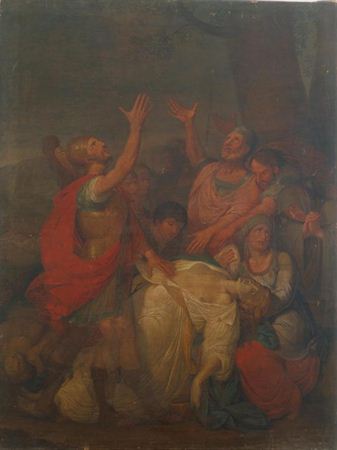José Teixeira Barreto began his apprenticeship as a painter in the workshop of his father, a painter, gilder and woodcarver. At the age of 19, he took the Benedictine habit at the Monastery of S. Martinho de Tibães in Braga, adopting the name Frei José da Apresentação.
During this early phase of his life, he executed several paintings for the monasteries of Tibães and Santo Tirso. When he went to Lisbon to study drawing under Professor Joaquim Manuel da Rocha, he moved to the Monastery of S. Bento da Saúde (today the building of the Assembly of the Republic).
In 1790, five years after moving to Lisbon, he travelled to Rome to perfect his painting, visit Italian art museums and copy works of Classical Art. Among the works he produced there were two etchings dated 1794 and 1795, dedicated to his patron, and 41 engravings for the book “Scherzi Poetici Pittorici” by Giovanni Gherardo Rosse, published in the deluxe edition of this work (Parma, 1811), offered to Napoleon.
On his return to Portugal, he brought a collection of paintings with which he created a museum in the Tibães Monastery (dispersed after 1834 and which became part of the Museu Portuense, now the Soares dos Reis National Museum), relics of the virgin and martyr Santa Clara, deposited in the church of Terço (1798) and later transferred (1803) to the chapel of Bonfim, and three books of drawings by him, two of which now belong to the Faculty of Fine Arts of the University of Porto and the other to the Soares dos Reis National Museum.
In the post-Roman period, he produced the paintings for the high choir of the parish church of Santo Tirso, the canvas for the dressing room of the high altar of the church of the Venerable Third Order of S. Francisco in Porto (c. 1800), the canvas for the high altar of the parish church of S. João da Foz in Porto, paintings for the monasteries of S. João da Pendorada and Santa Maria de Pombeiro, and possibly two canvases for the monastery of S. Lourenço in Porto. João de Pendorada and Santa Maria de Pombeiro monasteries, possibly two canvases for the Porto church of S. Lourenço which are now kept in the Soares dos Reis National Museum (“S. Pedro showing the Eucharist” and “O Maná”), the portrait and self-portrait (Soares dos Reis National Museum) and a portrait of the painter Francisco Vieira, the Portuense.
Towards the end of his life, he applied to rejoin the Benedictine order. However, death surprised him on 6 November 1810. He was buried the following day in a shallow grave with the number 18 on the cross of the church of the Monastery of S. Bento da Vitória in Porto. José Teixeira Barreto left a valuable legacy, made up of his pictorial work and the paintings he collected.

